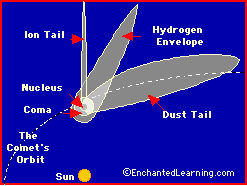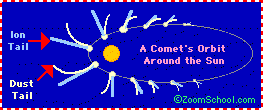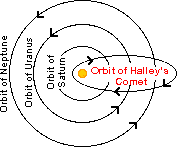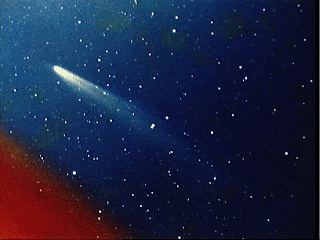PARTS OF A COMET
 Nucleus: The nucleus is the frozen center of a comet's head. It is composed of ice, gas, and dust. The nucleus contains most of the comet's mass but is very small (about 1 to 10 km across - or more).
Nucleus: The nucleus is the frozen center of a comet's head. It is composed of ice, gas, and dust. The nucleus contains most of the comet's mass but is very small (about 1 to 10 km across - or more).
Coma: The coma is the roughly spherical blob of gas that surrounds the nucleus of a comet; it is about a million km across. The coma is comprised of water vapor, carbon dioxide gas, ammonia, dust, and neutral gases that have sublimed from the solid nucleus. The coma and the nucleus form the head of a comet.
Ion Tail: A tail of charged gases (ions) always faces away from the sun because the solar wind (ions streaming from the sun at high velocities) pushes it away (it is also called the plasma tail). When the comet is approaching the Sun, the ion tail trails the comet: when the comet is leaving of the Sun, the ion tail leads. The tail fades as the comet moves far from the Sun. The ion tail can be well over 100 million km long.
Dust Tail: The dust tail is a long, wide tailcomposed of microscopic dust particles that are buffeted by photons emitted from the Sun; this tail curves slightly due to the comet's motion. The tail fades as the comet moves far from the Sun. Hydrogen Envelope: Hydrogen gas surrounds the coma of the comet and trails along for millions of miles (it is usually between the ion tail and the dust tail). The hydrogen envelope is about 10 million km across at the nucleus of the comet and about 100 million km long. It is bigger when the comet is near the Sun.
A COMET'S ORBIT
 Comets orbit the Sun in highly elliptical orbits. Their velocity increases greatly when they are near the Sun and slows down at the far reaches of the orbit. Since the comet is light only when it is near the Sun (and is it vaporizing), comets are dark (virtually invisible) throughout most of their orbit. The solar wind pushes the tail away from the Sun.
Comets orbit the Sun in highly elliptical orbits. Their velocity increases greatly when they are near the Sun and slows down at the far reaches of the orbit. Since the comet is light only when it is near the Sun (and is it vaporizing), comets are dark (virtually invisible) throughout most of their orbit. The solar wind pushes the tail away from the Sun.
 Some comets crash into the Sun or get so close that they burn up; these comets are called sungrazers.
Some comets crash into the Sun or get so close that they burn up; these comets are called sungrazers.
A COMET'S ORBIT
COMET EXPLORATION
COSMIC SNOWBALLS
There is a new and very controversial theory that comets (composed of frozen water) are constantly bombarding the Earth. These "cosmic snowballs" have (perhaps) been seen by the visible imaging system of the Polar Satellite. In theory, these frozen comets vaporize in the atmosphere, adding water vapor to the environment.
QUESTIONS AND ANSWERS
1. What is a comet?
Comets are small, fragile, irregularly shaped bodies composed mostly of a mixture of water ice, dust, and carbon- and silicon-based compounds. They have highly elliptical orbits that repeatedly bring them very close to the Sun and then swing them into space. Comets have three distinct parts: a nucleus, a coma, and a tail. The solid core is called the nucleus, which develops a coma with one or more tails when a comet sweeps close to the Sun. The coma is the dusty, fuzzy cloud around the nucleus of a comet, and the tail extends from the comet and points away from the Sun. The coma and tails of a comet are transient features, present only when the comet is near the Sun.
2. How did comets form?
Our entire solar system, including comets, formed from the collapse of a giant, diffuse cloud of gas and dust about 4.5 billion years ago. When the cloud started its collapse, it was rotating very slowly. But the cloud began to heat up and whirl faster as it shrank, just as twirling ice skaters spin faster by bringing their arms close to their bodies. The fast rotation helped ensure that not all of the material fell into the core. Instead, the material in the fast-spinning cloud spread out into a flattened disk. Meanwhile, the temperature in the dense, central core was heating up. The core eventually became so hot that it ignited nuclear fusion, creating the Sun. The disk's outer regions, however, were quite cold. The low temperatures allowed water to freeze onto dust grains, which grew in size to make clumps. Some clumps eventually reached a size of several kilometers in diameter. The clumps then began merging, probably by collisions, and formed the planets. Many theories abound about how these clumps became planets. This topic is at the forefront of scientific research. Whatever the details, large planets were created from the buildup of clumps of matter and gas from the surrounding cloud. But some of this matter did not merge into planets. Within the last decade, for example, astronomers discovered leftover clumps, called planetesimals, in a region beyond Neptune, although no large planets formed beyond that planet. These bodies form an outer asteroid belt at the edge of the solar system, called the Edgeworth-Kuiper belt, named for the scientists who proposed its existence in the 1950's. Recent calculations show that this asteroid-rich Kuiper belt (as it is now known) is probably the source of most of the short-period comets, such as Halley's comet, which orbits the Sun every 76 years.
3. Why do comets have tails?
A comet's tail is its most distinctive feature. As it approaches the Sun it develops an enormous tail of luminous material that extends for millions of kilometers away from the Sun. When far from the Sun, a comet's nucleus is very cold and its material is frozen. Water ice, as well as other compounds such as carbon dioxide and carbon monoxide ice, may be found in the nucleus. This icy nucleus changes radically when a comet approaches the Sun. The intense solar wind from the Sun transforms the solid nucleus directly into a vapor, bypassing the liquid phase. This process is called sublimation. The vapor helps stir things up in the nucleus, forcing the core to form a cloud-like mixture of gas and dust around it, called the coma. There, sunlight and the solar wind interact with the ingredients, creating the tails. The ingredients in the coma determine the types and number of tails. Some comets may appear to have no tails, but they really do. They are simply very faint. Scientists can identify these tails by using special filters that are sensitive to dust or gas emissions. Other comets, like Hale-Bopp, which could be seen from Earth in 1997, have very prominent tails. Although Hale-Bopp's tails could be seen visibly from Earth, scientists using sensitive cameras identified a much more complicated tail structure. One of these images revealed a long, curving dust tail. Other pictures showed dust and gas ion tails. There was even an image of a dust tail and two gas ion tails. The different tails provide scientists with important information about the internal chemistry and structure of a comet's nucleus.
4. What are the types of comet tails?
There are two types of comet tails: dust and gas ion. A dust tail, which is usually yellow, contains small, solid particles that are about the same size as those found in cigarette smoke. This tail forms because sunlight acts on these small particles, gently pushing them away from the comet's nucleus. . Because the pressure from sunlight is relatively weak, the dust particles end up forming a diffuse, curved tail. A gas ion tail, which is usually blue, forms when ultraviolet sunlight rips one or more electrons from gas atoms in the coma making them into ions (a process called ionization). A solar wind then carries these ions straight outward away from the Sun. The resulting tail is straighter and narrower. Both types of tails may extend millions of kilometers into space. As a comet heads away from the Sun, its tail dissipates, its coma disappears, and the matter contained in its nucleus freezes into a rock-like material. Recent observations of the very bright comet Hale-Bopp pinpointed a tail made of sodium (Na), a relative of the gas ion tail. This tail forms when sunlight pushes on sodium atoms released from the nucleus.
5. What is the difference between a meteor, a meteoroid, a meteorite, an asteroid and a comet?
Most of us probably have seen meteors or shooting stars. A meteor is the flash of light that we see in the night sky caused by the friction of a meteoroid passing through our atmosphere. A meteoroid is an interplanetary chunk of matter smaller than a kilometer and frequently millimeters in size. (Note that the term "meteor" refers to the flash of light caused by the meteoroid, not the meteoroid itself.) Most meteoroids that enter the Earth's atmosphere are so small that they vaporize completely and never reach the planet's surface. If any part of a meteoroid survives the fall through the atmosphere and lands on Earth, it is called a meteorite. Although the vast majority of meteorites are very small, their size can range from about a fraction of a gram (the size of a pebble) to 100 kilograms or more (the size of a huge, Earth-destroying boulder). Asteroids are generally larger chunks of rock that come from the asteroid belt located between the orbits of Mars and Jupiter. Comets are asteroid-like objects covered with ice, methane, ammonia, and other compounds that form a coma and sometimes a visible tail whenever they orbit close to the Sun. As a comet rides through the solar system, it leaves little particles in its wake. If the Earth's orbit intersects this "wake" of particles, we see a meteor shower as the particles rain down through Earth's atmosphere.
6. Where do comets come from?
Comets are found in two main regions of the cosmos: the Kuiper belt and the Oort cloud. Short-period comets -- comets that frequently return to the solar system -- probably originate from an area called the Kuiper belt. This belt is located within the solar system's ecliptic plane, beyond the orbit of Neptune. Astronomers found the first object in the Kuiper belt in 1992. Since that discovery many objects have been discovered within that region. These objects are usually small compared with planets. Their size ranges from 10 to 100 kilometers in diameter. Earth's diameter, for example, is 14,000 kilometers. The Hubble Space Telescope may have detected a population of small comets dwelling in this region in space. Based upon the Hubble observations, astronomers estimate that this belt contains at least 200 million comets, which are thought to have remained essentially unchanged since the birth of the solar system 4.5 billion years ago. Long-period comets are thought to emanate from a vast, spherical cloud of frozen bodies called the Oort cloud, named for the Dutch astronomer Jan Hendrik Oort. This cloud of comets, which also orbits the Sun, resides in the farthest region of the solar system, beyond Neptune and Pluto. The Oort cloud objects are made up of matter such as frozen ammonia (), methane (
), cyanogen (
), water ice (
), and rock. Occasionally, a gravitational disturbance caused by a passing star or an interstellar cloud causes one of these bodies in the Oort cloud to begin a journey toward the inner solar system, where it makes a passing rendezvous with our Sun.
7. What path do comets follow through the solar system?
Planets have nearly circular orbits, whereas comets have elongated paths around the Sun. A comet is at aphelion when its orbit is farthest from the Sun. It is at perihelion when it is closest to the Sun. Due to gravitational effects, a comet will travel fastest at perihelion and will slow down as it approaches aphelion. Comets can be classified by their orbital period: that is, the time it takes them to make one complete trip around the Sun. Comets with short and intermediate orbital periods -- like comet Halley, whose orbital period is 76 years -- spend most of their time between Pluto and the Sun. These comets began as asteroids in the Kuiper belt, but a gravitational "push" from the planets, especially Jupiter, swung them closer to the Sun. Some of their orbital periods are shorter than 200 years. Comet Shoemaker-Levy 9 is an example of a comet that has been radically perturbed by Jupiter's gravitational effects. A long-period comet will have an orbital period of more than 200 years. Hale-Bopp, for example, completes an orbit every 2,400 years. Hale-Bopp once completed an orbit every 4,000 years, but during its last visit to the inner solar system, the comet passed so close to Jupiter that the planet's gravitational force altered its orbit. Scientists think that this type of comet spends most of its time way out in the Oort cloud at the farthest edge of our solar system.
My fascination with the stars began in the third grade, if not earlier. While many people share this fascination and find comfort and inspiration in the stars, my immediate reaction was "That's neat! I wonder where they came from?" I remember reading every book on astronomy in my school library before I hit the fourth grade --- there were only two or three. Telescopes fascinated me as well, but I was disappointed by the view through them, which was frequently fuzzy. Through a telescope, the stars looked like stars, little points of light. But the planets - ah! I'll never forget my first view of Saturn, hanging there like a little perfect model. Watching Mars' seasons taught me about patience, as well as global weather patterns. For example, in the Martian winter, Mars' ice cap can cover most of a hemisphere.
Now I hardly ever use a telescope for pleasure. I have some binoculars and love to wander through the Milky Way on dark nights. But looking at pictures taken with a telescope can give me the same sense of awe. The size of an image taken with the Hubble Space Telescope covers the same amount of sky as that concealed by a grain of sand held at arm's length. Yet, as the Hubble Deep Field picture shows, that tiny bit of sky contains hundreds of galaxies like ours, or even bigger. It makes me wonder where they all came from.
-Alex Storrs
Views of Comets
- Comet Neat
This image of comet C/2001 Q4 (NEAT) was taken at the WIYN 0.9-meter telescope at Kitt Peak National Observatory near Tucson, Arizona, on May 7, 2004.
The image was captured with the Mosaic I camera, which has a one-square degree field of view, or about five times the size of the Moon. Even with this large field, only the comet's coma and the inner portion of its tail are visible. A small star cluster (C0736-105, or Melotte 72) is visible in the lower right of the image, between the head of the comet and the bright red star in the lower-right corner. (Courtesy NASA, NOAO, NSF, STScI)
- Comet Kohoutek
This color photograph of the comet Kohoutek was taken by members of the lunar and planetary laboratory photographic team from the University of Arizona. They photographed the comet from the Catalina observatory with a 35mm camera on January 11, 1974. (Courtesy NASA)
- Comet Hyakutake
These Hubble Space Telescope images of comet Hyakutake were taken on March 25, 1996 when the comet passed at a distance of 9.3 million miles from Earth. These images focus on a very small region near the heart of the comet, the icy, solid nucleus and provide an exceptionally clear view of the near-nucleus region of the comet.
The left image is 2070 miles across (3340 km) and shows that most of the dust is being produced on the sunward-facing hemisphere of the comet. Also at upper left are three small pieces which have broken off the comet and are forming their own tails. Icy regions on the nucleus are activated as they rotate into sunlight, ejecting large amounts of dust in the jets that are faintly visible in this image. Sunlight striking this dust eventually turns it around and "blows" it into the tailward hemisphere.
The bottom-right image is an expanded view of the near-nucleus region and is only 470 miles (760 km) across. The nucleus is near the center of the frame, but the brightest area is probably the tip of the strongest dust jet rather than the nucleus itself. Presumably, the nucleus surface lies just below this bright jet. The top-right image shows pieces of the nucleus that apparently broke off. The image shows at least three separate objects that are probably made up of coarse-grained dust. Large fragments of the nucleus would not be accelerated into the tail, which appears to be the case in this image. (Credit: H. A. Weaver--Applied Research Corp., HST Comet Hyakutake Observing Team, and NASA)
- First X-Rays From Comet Hyakutake Discovered
This image shows the discovery of a strong X-ray radiation signal coming from comet Hyakutake. The image was made on March 27, 1996 using Germany's orbiting ROSAT satellite. The comet was near its closest approach to the Earth at a distance of less than 10 million miles when X-ray emmisions were first detected by ROSAT. The strength and rapid changes in intensity of the comet's X-ray emission both surprised and puzzled astronomers. "We had no clear expectation that comets shine in X-rays," said Dr. Michael J. Mumma of NASA's Goddard Space Flight Center, Greenbelt, MD. X-rays have never been found from a comet before, and scientists had optimistically predicted an intensity that turned out to be about 100 times weaker than the radiation actually detected by ROSAT. Strong changes in the brightness of the X-rays were another surprise. There were pronounced increases and decreases in the X-ray brightness from one ROSAT observation to another, typically over a time difference of a few hours.
Still another puzzle is the nature of the physical process that generates the X-rays, but the ROSAT image may contain clues to this process. In the image, the X-rays from the comet seem to come from a crescent-shaped region on the sunward side of Comet Hyakutake. One preliminary theory is that X-ray emission from the Sun was absorbed by a cloud of gaseous water molecules surrounding the nucleus of the comet, and then were re-emitted by the molecules in a process physicists call "fluorescence." According to this idea, the cloud is so thick that its sunward side absorbs nearly all the incoming solar X-rays, so that none reach the remainder of the cloud. This could explain why the cometary X-ray emission has the form of a crescent, rather than that of a sphere around the nucleus. A second possible explanation is that the X-rays are produced from the violent collision between the comet material and the supersonic "wind" of plasma and particles streaming away from the Sun.
- Comet 1993a Mueller
This is a CCD image of comet 1993a Mueller, taken on October 6, 1993 with a 288mm f/5.2 Schmidt-Cassegrain telescope. The comet has a coma diameter of 3' and a fan-shaped tail, up to 7' long. (Courtesy Erich Meyer and Herbert Raab, Austria)
- Comet West (1975)
This photograph was taken by amateur astronomer John Loborde on March 9, 1976. This picture shows two distinct tails. The thin blue plasma tail is made up of gases and the broad white tail is made up of microscopic dust particles. (Courtesy John Laborde)
This image of comet West was taken by John Laborde at the Tierra Del Sol Observatory site in San Diego County. The exposure was 30 minutes with a 135 mm Nikon lens. (Courtesy John Laborde)
- Comet Hale-Bopp
These NASA Hubble Space Telescope pictures of comet Hale-Bopp show a remarkable "pinwheel" pattern and a blob of free-flying debris near the nucleus. The bright clump of light along the spiral (above the nucleus, which is near the center of the frame) may be a piece of the comet's icy crust that was ejected into space by a combination of ice evaporation and the comet's rotation, and which then disintegrated into a bright cloud of particles.
Although the "blob" is about 3.5 times fainter than the brightest portion at the nucleus, the lump appears brighter because it covers a larger area. The debris follows a spiral pattern outward because the solid nucleus is rotating like a lawn sprinkler, completing a single rotation about once per week.
This image of comet Hale-Bopp was taken by John Laborde with his home designed and built, 8.8" f/3.7 Wright Schmidt Camera. The picture was taken at the Tierra Del Sol Observatory site in San Diego County with a 25 minute exposure on Kodak PPF400 film. (Courtesy John Laborde)
This image of comet Ikeya-Seki was taken by John Laborde in Poway, California just before dawn. The exposure was 15 minutes with a 55 mm Nikon lens. (Courtesy John Laborde)










No comments:
Post a Comment